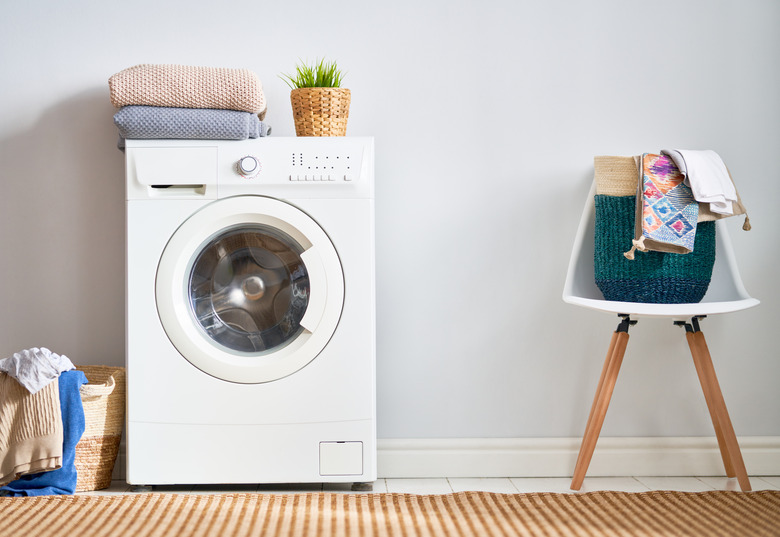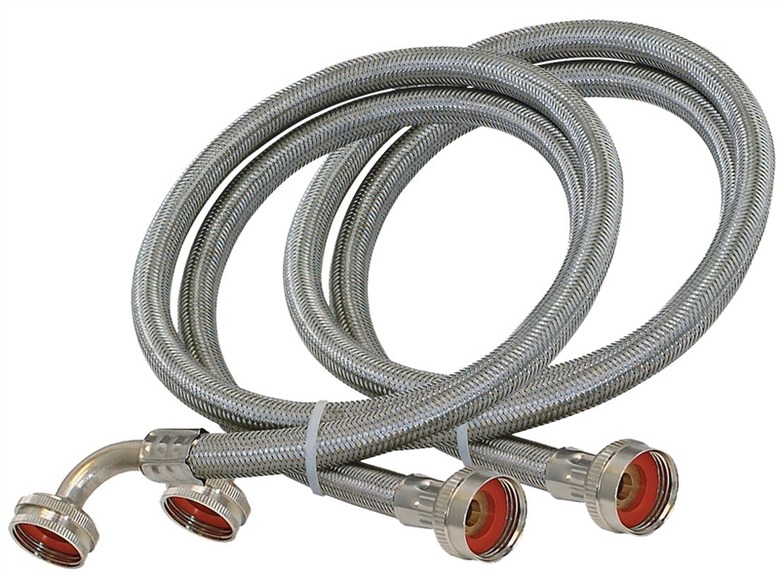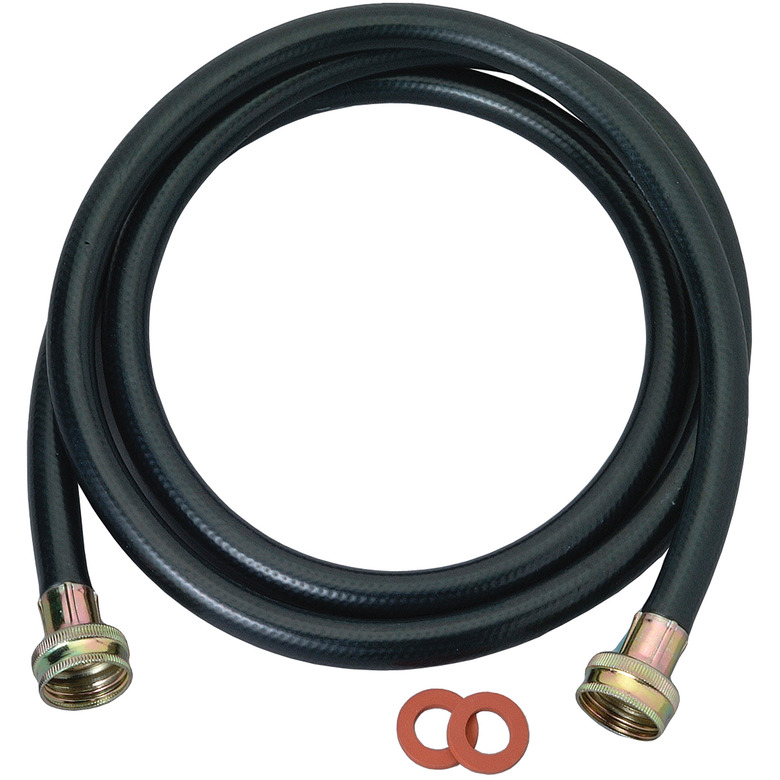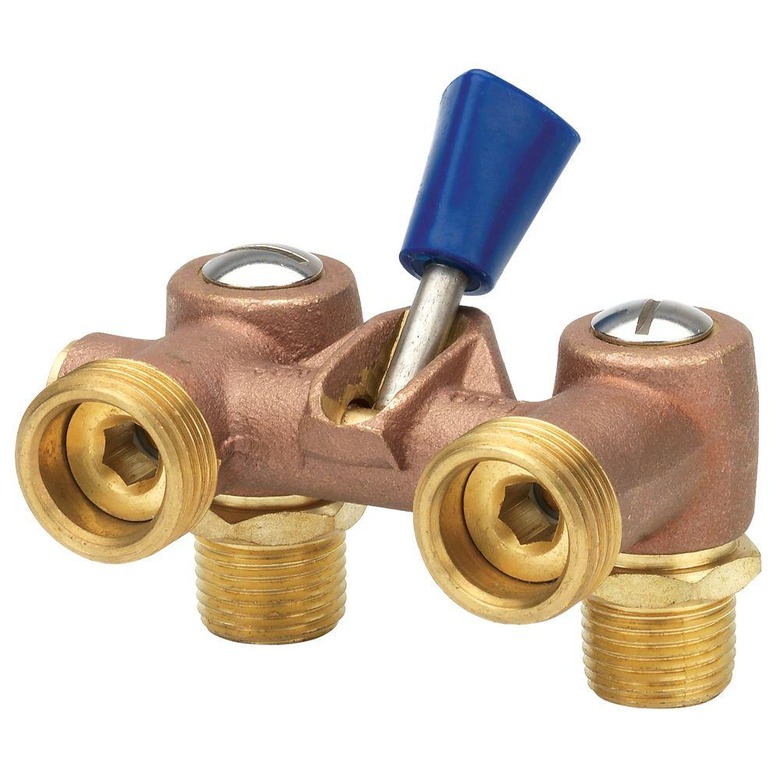What To Know About Replacing Washing Machine Hoses
A washing machine hose is a lot like a garden hose—it's just shorter and, in a sense, has stakes that are a lot higher. The stakes are a lot higher because washing machine hoses are always on, always holding back pressurized water. You probably wouldn't leave your garden hoses on under full pressure while you're on vacation, but most people never take the same precaution with their washing machine. For this reason, it's important to use good-quality hoses and to be alert to problems or wear and tear with older hoses. If a cheap, old or faulty hose ever does spring a leak, you'd better hope you're not on vacation, or even asleep.
Washing machine hoses flood houses all the time, and they can cause severe damage in a matter of minutes. The good news is that buying and replacing washing machine hoses is no more complicated than hooking up a new garden hose.
When to Replace Washing Machine Hoses
When to Replace Washing Machine Hoses
The best time to replace your hoses depends on what type of hoses you have and how old they are. If you have plain black-rubber hoses and they look to be more than a few years old, you should consider replacing them soon. Basic rubber hoses can work trouble-free for years, but they have a historically poor record for springing leaks. If the hoses seem to be very old, you should replace them ASAP. The same goes for hoses showing any signs of wear, such as cracks, bulges, abrasions or soft areas. Hoses that are pushed against the wall and are bent sharply or kinked also are prone to leaking.
If a washing machine hose leaks a bit where it connects to the water supply valve or to the back of the washer, you can try replacing the rubber sealing washer inside the threaded hose fitting, which is just like the ones that fail periodically on garden hoses. However, a bad rubber washer usually indicates the washing machine hose is old, so it's a safer bet to simply replace the hoses.
Which Washing Machine Hoses to Use
Which Washing Machine Hoses to Use
Choosing a hose is simple: Go straight for the "burst-proof" hoses that have an outer layer of braided stainless steel. This steel braiding reinforces the plastic (usually PVC) or rubber hose within, to prevent weak spots that can lead to leaks. Don't bother with unreinforced rubber or plastic hoses, no matter what claims about leak-resistance are made on their packaging.
Chances are, you will have only few brand options among the steel hoses, but if one is notably less expensive that the others, go for the more expensive hoses. This is not a good place to save a few bucks.
Standard washing machine hoses have a 3/4-inch female threaded fitting on each end. This is the same female fitting found on garden hoses. Washing machine hoses also come in a few different lengths, from 4 feet to 10 feet. Finally, you can get hoses with straight ends or with a 90-degree elbow on one end. The elbow allows the hose to install snugly against the wall so its nice and tidy behind the washing machine. Make sure the hoses you get will work for your supply valves and washer placement.
How to Replace Washing Machine Hoses
How to Replace Washing Machine Hoses
If you've every installed a garden hose on an outdoor faucet, you're fully qualified to replace your washer hoses:
- Turn off the water supply valves behind the washing machine
by turning each knob clockwise until
it stops. If the valves have lever-type handles, turn them so the handle is perpendicular to the water pipe. - Unplug the washing machine's electrical plug from the wall.
- Pull the machine out from the wall, just enough so you can
access both ends of the hoses. It's easiest to shimmy the machine by sliding out
each side a few inches at a time. - Note which hose connects the hot water and which connects the
cold water. Typically, the hot water valve is on the left. You want to install
the new hoses in the same way. - Unscrew each of the hoses from the supply valve. You may
need to loosen the fitting with a pair of tongue-and-groove pliers (regular
pliers will work in a pinch). Keep a rag handy to catch residual water in the
hose. - Unscrew the other end of each hose from the washing machine.
If you keep the hose ends up they won't spill all of their water onto the floor;
otherwise, you can drain each hose into a bucket or utility sink. - Install the new hoses one at a time: hot to hot, cold to cold.
Tighten each fitting gently with pliers, being careful not to damage the valve
or stress the washer connection (usually plastic). - Push the washer back into place, making sure the hoses are
not kinked. - Open the supply valves all the way, then check for leaks at
the hose ends. - Plug the washer cord back into the wall. Done!
Protecting Against Washing Machine Hose Leaks
Protecting Against Washing Machine Hose Leaks
Despite your best efforts to make sure your washer hoses are in good shape, the potential for a leak is always there—again, because the hoses are holding back pressurized water, unless you shut off the supply valves. If this concerns you, there are a couple of ways to minimize the risk of a washer-related flood. One is to simply turn off the water supply valves when you leave home for extended periods. This stops the pressurized water at the valve, so the hoses are no longer under pressure. You can simplify this task by installing a single-handle valve that controls both the hot and cold water with one lever.
The other prevention method is to install an automatic shutoff system that checks for leaks around the washer and can shut off the water supplies itself. It also sounds an alarm to alert you that the shutoff function has been deployed. These systems start at around $200 and include a valve control unit, a sensor that lies on the floor below the washer and a power cord that plugs into a standard wall outlet.
The control unit installs between the water supply pipes and the washer hoses. If the sensor detects water on the floor—due to a leaky hose or an overflowing or leaking washing machine—the control unit shuts off both water supplies, and the alarm sounds. The water stays off until you reset the unit with the push of a button.



